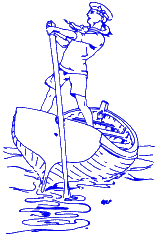The “Leander” Group has evolved from the original 2nd Kingston Scout Troop. There is no record of how or when this troop was established. It came into existence in 1908 following the publication of “Scouting for Boys” in six fortnightly parts in the early months of that year. The first meetings were probably held somewhere in the Spring Grove area of Kingston.
The first Scoutmaster was Erik Robinson, son of Mark Robinson, a well-known marine engineer. No doubt this fact played some part in the troop becoming Sea Scouts in a few years time. Except for service in the Great War, Erik Robinson continued as Scoutmaster until December 1921. He was succeeded by Eric Ebbage who carried on as Scoutmaster and later as Group Scout Leader until July 1968 when he handed over to Peter Burton. Over the years these three have had the assistance of approximately one hundred adult helpers in various ranks in the Cub, Scout, Rover and Venture Scout Sections. The Group has been well served by this devoted band of Leaders and Instructors.
When the Boy Scouts Association was incorporated in 1909 the 2nd Kingston Troop was registered as No. 3424 on 3 April. Nothing is known of the Troop’s activities until 1911 when, on 5 July, it was present at a National Scout Rally in Windsor Great Park in the presence of H.M. King George V. The next month a week’s camp was held at Box Hill. Easter 1912 saw the first Hike Camp with nights spent at Virginia Water, Wisley and Box Hill. A Summer Camp took place at Fort Cumberland, Portsmouth in the same year.
In November 1912, the Troop commenced its Sea Scouting activities with its first boat - an ex Navy 32ft 12-oared cutter. This was presented to the Troop by the great-grandson of Captain Francis Grove, R.N., on the Centenary of his great-grandfather joining the Navy, who had commanded H.M.S. LEANDER in the early years of the last century. When some years later, the Boy Scouts Association introduced the Group Organisation, the title LEANDER (Kingston) Sea Scout Group was adopted.
In 1913 the Troop obtained riverside headquarters adjoining the Hogs Mill River below Clattern Bridge in what had formerly been Burgoine’s, a well-known firm of boat builders. When these premises were taken over for war work in 1915 the troop moved to an old stable and hay loft at the back of the "Druid’s Head" in Kingston Market Place. The Headquarters in Lower Ham Road were first rented in 1921.
In August 1913, the Troop spent a week sailing around the South Coast in the 60ft ketch “Mirror”. This cruise was an early forerunner of the deep sea cruises now provided for young people by a number of organisations.
The Wolf Cub Pack (No. 1805) was registered on 21 September 1918. The first Cubmaster was Miss Ellen Brady (now Mrs. Arthur Millest). Her assistant, Mrs. Myers, later succeeded her as Cubmaster.
Since 1913 the Group’s activities, often suggested by the boys themselves, have been of the widest variety and much too numerous to list in this brief history. Apart from the primary duty to teach obedience to the Scout Law and Promise, the job of a Leader in a Sea Scout Group is largely to inspire, encourage and prepare boys for adventure afloat with the object of developing self-reliance.
During the whole of its life of 75 years, the Group has established an outstanding reputation for its achievements. Much of its progress has been dependent upon suitable equipment and headquarters. At the present time it possesses a fleet of boats which provide training for boys of all ages. Following the serious fire two years ago, the Group now looks forward to new headquarters with greatly improved facilities.
Skip to main content
